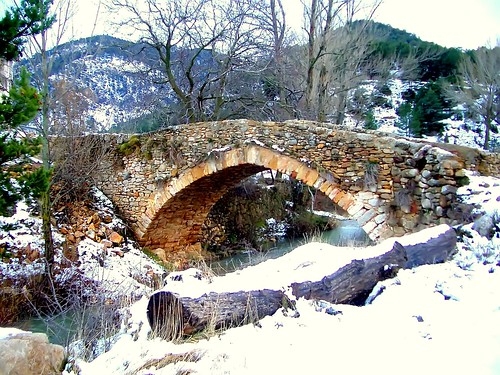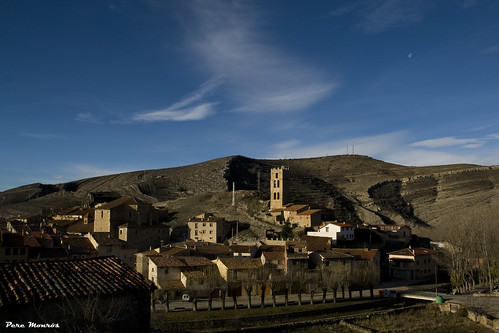
The routes are long Allepuz why the mention at each point, which are:
Route 1 – River Valley And Birth Sollavientos. Across the road from Allepuz a track down to the river. » From the picnic we go along the narrow river Sollavientos leaving behind several sources: the cress, de los Banos, Health … So get to the mill of Tormagal, a hillside covered with hazels by the river jumps over the rocks. The road leading to Valdelinares Sollavientos through the valley, covered all year by green meadows. In the midst of the valley, the church of Santa Isabel is the only vestige of the old village of Sollavientos. Nearby is the fountain of Santa Isabel. When it is filled, water overflows above, to the upwelling of the Mas Don Pedro.
Once at the top of the Port of
Valdelinares, Fortanete forest track takes us to the mountains of Tarrascón, Peñacerrada and the cave in the pipes of Boca Negra. Another option is to go to the valley of cuerte Prado y la Hoya del Fraile, and in Valdelinares or climbing to the tops of the stove Zaragozana and over 2000 meters.

Route 2 – River Valley and White birth or Alfambra. Gúdar pipes. From Allepuz, Gúdar the road enters the White River valley, passing through places like the source and recreational area of the mill, the gorge of Umbria, a pond to the left of the road before Gúdar population, and After this, the parking lot of the Sewers of Gúdar. In a short walk of 400 meters between pine, yew, lime and holly and crossing the river by bridges and wooden walkways on several occasions, to reach where the river breaks. Also from the junction of Gúdar we get to the Source of Healing in the valley.
Route 3 – source of the river valley and Linares. Linares The river rises in the foothills of the mountains and Monegro Peñarroya to over 2,000 meters high, surrounded by forests of black pine and creeping junipers. In the cliffs of Valdelinares Tajer can find up to 50 yews. The river descends through the meadows of daffodils and Closed gentian to the Raft, an ancient lake with maple, hazel and other deciduous species.
Route 4 – Source of the River Valley And Guadalope. The Sabinar and sorrows of La Morta (from Miravete de la Sierra, Aliaga road), is a natural garden as aesthetic seems to have been designed by man.
From the Pine Villarroya we can head for the Sierra Miravete the narrow river Guadalope or to Puerto de Villarroya and from there to the source of the river, walking a few kilometers. We can also access the birth from the valley up the hill Sollavientos there to the left of Mas Quemado.
Route 5 – River Valley And Birth Mijares. From Cedrillas, Alcalá address, find the trail of the Birth of the Mijares River, and bordering the Upper Mill, get to the picnic area and the spring, next to a shady forest of Scots pines, yew, linden, elm, mountain, aspen, rowan and hazel
Route 6 – Source of the River Valley and Alcalá. Behind the shrine of the Virgen de la Vega, in the way of RISCLE Source, is a natural lake.
From Alcala de la Selva and the road towards the cliff Cedrillas del Espino will take us a few meters from Shaker Alcala, a single forest of aspen Cultural routes
Cultural routes:
Route of rebirth. During the S. XVI and XVII, the vernacular architecture of Maestrazgo dressed as Italian influences. The booming textile industry (wool fabric) raised numerous buildings that are typical of the urban populations.
From the cover of the Big House, we can see the old fountain, across the street from the Moon, with arch. Down the street from the East, Market or come to the fore, with two arches and stone masons marks in the columns. City Hall is also in this period, in the Plaza Mayor, whose rear facade presents a carved wooden balcony flown. Following the main street, we arrive at another house-palace, is of Gothic influences and later the House of the Count of Florida. From the Plaza de la Iglesia, we can see the top 3 floors of the palace or Allepuz Casa Grande, with its arched gallery upstairs. A roadside stands, as in the other localities of travel, a shrine of Loreto, dated 1692, and it shows, with its atrium, the same typology as the rest of the itinerary.
Lana Route: The Way of the Basins, recently declared a Historic Cultural Heritage Aragon, was part of the Camino Real that connected Maestrazgo Teruel and the Mediterranean. As he traveled Maestrazgo products (mainly wool and tissues and less so spelled) that were exported throughout the Mediterranean and gave much wealth to this land. James I the Conqueror, use this route to Peniscola, through Allepuz and Villaroya, as the «Llibre dels Chronicle Feyts or historic.» The path is formed by 113 stone pillars seventeenth century, along six miles, linking the towns of Allepuz with Villaroya of Pine. Of 2’50 feet tall and a diameter of 0.65 meters, served as a guide in the days of blizzard, snow or fog. From the Convention Allepuz and Calle de la Luna up a path carved into the rock by which access to the historic site.

Holidays:
On July 2 is made pilgrimage to the shrine of St. Elizabeth. On 22 July we celebrate the feasts in honor of St. Mary Magdalene. The October 12th marks the day of the Pilar.
Bon voyage!
Leave a Reply
You must be logged in to post a comment.
Recent Comments